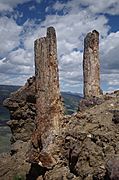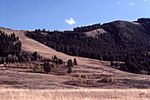Specimen Ridge facts for kids
Quick facts for kids Specimen Ridge |
|
|---|---|

North face Specimen Ridge from Lamar Valley
|
|
| Highest point | |
| Elevation | 8,379 ft (2,554 m) |
| Geography | |
| Location | Yellowstone National Park, Park County, Wyoming, U.S. |
| Parent range | Washburn Range |
| Topo map | Amethyst Mountain |
Specimen Ridge is a cool ridge about 8.5-mile (13.7 km) long in Yellowstone National Park. It sits along the southern edge of the Lamar Valley. This ridge separates the Lamar Valley from another area called Mirror Plateau. Specimen Ridge stretches from the Tower Junction area all the way to Amethyst Mountain.
People know Specimen Ridge because it has lots of interesting rocks. You can find amethyst, opal, and especially petrified wood here. Miners in the past called it Specimen Mountain. They probably named it before 1870 because of all the cool "specimens" they found. There's a hiking path called the Specimen Ridge Trail. It's about 18.8-mile (30.3 km) long and goes along the south side of the ridge. This trail passes through the famous Petrified Forest and even goes over the top of Amethyst Mountain, which is 9,614 feet (2,930 m) high.
Contents
What is Specimen Ridge Made Of?
Specimen Ridge is mostly made of a type of rock called the Lamar River Formation. This formation is a mix of different kinds of rock. It has a lot of conglomerate, which is rock made of many different sized pebbles and stones stuck together. It also has layers of tuffaceous sandstone and siltstone. These are rocks made from fine volcanic ash and sand.
How the Rocks Formed
The rocks here were formed by a mix of mudflows and ancient rivers.
- Mudflows: Imagine a thick, fast-moving river of mud, rocks, and volcanic ash. These are called lahars. When they stopped, they left behind messy layers of conglomerate.
- Rivers: There were also ancient rivers, some that braided (split into many channels) and some that meandered (curved and wound). These rivers carried and dropped sediments, forming more organized layers of conglomerate, sandstone, and siltstone.
Most of the amazing petrified wood you find here is inside these conglomerate rocks. The fossil leaves, needles, and pollen are usually found in the finer sandstone and siltstone layers. These finer sediments were laid down along riverbanks, in old river channels, or in small lakes. All these materials came from an ancient Eocene stratovolcano nearby, called the 'Washburn Volcano'.
Ancient Volcanoes and Rock Layers
The Lamar River Formation is part of a much larger group of volcanic rocks called the Absaroka Volcanic Supergroup. This supergroup is made of many layers of volcanic rocks. These rocks either erupted from huge volcanoes or were washed down from their slopes. These ancient volcanoes were enormous, perhaps 8,000 feet (2,400 m) to 10,000 feet (3,000 m) taller than the valleys around them!
The rocks of the Lamar River Formation sit on top of even older rocks. These older rocks can be ancient lava flows, other volcanic rocks, or even very old limestones and gneiss. Scientists know the Lamar River Formation is from the Middle Eocene period, which was millions of years ago. They figured this out by studying the plant fossils and using special dating methods on the rocks.
Yellowstone Petrified Forest
Specimen Ridge is famous for its incredible Yellowstone Petrified Forest. This forest isn't made of living trees, but of trees that have turned into stone! You can see upright petrified tree trunks and many layers of buried petrified forests. Scientists have been studying these amazing fossils for over 130 years.
How Trees Turn to Stone
The Yellowstone Petrified Forest has two main types of fossilized trees:
- Trees Buried in Place: Some rare layers show forests that were buried exactly where they grew. This happened when volcanic mudflows or river floods quickly covered the trees.
- Transported Trees: Most of the petrified logs and stumps were carried by mudflows or rivers from higher up the volcanoes. They were then buried in new locations.
It's pretty cool how this happens! For example, when Mount St. Helens erupted in 1980, it created similar layers of mudflows and river deposits. Scientists found that logs and upright tree trunks buried by these events were already starting to turn into stone. This happens when water rich in silica (a mineral) soaks into the wood, slowly replacing the wood cells with stone.
Protecting the Fossils
It's very important to remember that collecting fossils in Yellowstone National Park is against the law. To help protect these amazing natural treasures, visitors should always stay on the marked trails.
- Images of Specimen Ridge
-
Location of the petrified forest on Specimen Ridge, 1938
-
Specimen Ridge from Mount Washburn, 1977






